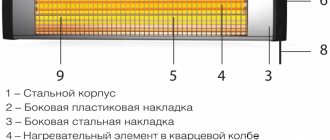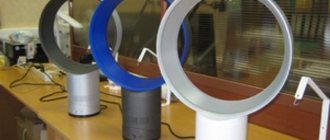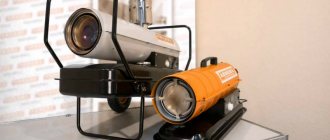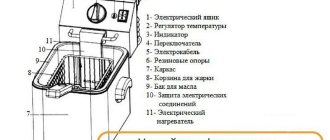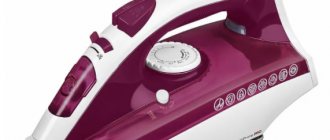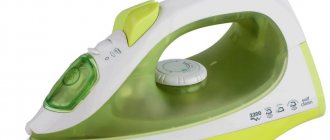What is a micathermic heater and how does it work?
So, a micathermic heating device is an innovative technology borrowed from the space industry. It is based on the ability of some materials to emit waves in the infrared range. Our sun “works” in the same range. While objects are exposed to its rays, they heat up. As soon as they go into the shadows, they cool down.
In the heaters that we are considering, the radiating element is plates made of multilayer material coated with mica. It itself does not heat up, so you can safely touch mikanite without the risk of getting burned. Due to the special structure of the plates and the absence of heating, they practically do not wear out during operation. Mikanites are enclosed in a metal case with a one-sided or double-sided grille. The heat from the heating elements spreads almost instantly from the moment the device is turned on.
Diagram of a micathermic battery device
At the end of the device there is a control unit that regulates the temperature. Expensive models are additionally equipped with an LCD display.
In micanites, upon contact with electrical energy, the process of reflection and isolation of thermal energy occurs, and the dielectric mica covering them transmits infrared radiation to the surrounding space.
A fifth of the thermal energy comes from the heater by convection, due to air movement. Everything else is infrared
What is a micathermic heater
A micathermic heater is an electrical device that is capable of distributing infrared heat waves. Infrared heat is considered electromagnetic radiation, which occupies the region of the spectrum between the generated microwaves and the red edge of visible light.
The heating device is equipped with a multilayer structure. Incoming layers that perform specific functions can be either metallic or non-metallic. One part of them helps to isolate heat waves, others are aimed at their concentration and reflection.
The power of the heaters is in the range of 1500-3000 W. Each IR device is equipped with a mechanical or electronic control type.
Pros and cons of a micathermic heater in practical use
There are no ideal heating devices. Even cheap gas installations have their drawbacks. Micathermic heaters are not without them. Let's look at the medal from both sides.
Advantages
- Environmental friendliness : Heating of premises occurs using infrared and electromagnetic waves, which do not pose a danger to humans and pets. The device does not emit any toxic fumes.
- Fast heating : The room temperature rises in a matter of minutes, the device can work for a long time.
- Energy savings : Compared to other plug-in appliances, these heaters consume 30% less energy.
- Safety : The device body does not heat up above 60°C. So the battery does not burn if accidentally touched.
- Installation versatility : Heaters operating on the principle of infrared radiation can be installed in indoor and outdoor areas.
- No noise during operation : The thermal expansion of micanites corresponds to the expansion of the device core, so you will not hear the usual clicks when heating.
- Light weight : IR batteries are compact and lightweight, they can be carried from room to room, hung on the wall or placed on the floor.
- Availability of additional options : Timers, thermoregulation and air ionization devices are built into modern heater models. You can purchase a model with additional stands for drying shoes or clothes.
- Directional action : Thermal energy in such heating devices, as a rule, comes from one side. This is very convenient if you need to heat a specific area, for example, the bed area.
Flaws
- Limited range : To feel the heat from the battery, you need to be close to it. IR radiation heats objects, not air.
- Difficulty in cleaning : The most unpleasant thing is that house dust accumulates in the radiator grille and then, when heated, can spread an unpleasant odor. It is necessary to periodically clean the grate with a vacuum cleaner and do wet cleaning.
- High cost : Space technology is not yet a cheap pleasure. But it's only a matter of time. You can buy micathermic heaters for a price starting from 4,000 rubles.
How does a micathermic heater work?
This type of heater is based on a new generation heating device. Its design does not use nichrome spirals, graphite or high-intensity metal-ceramic heaters. If you look closely at the device, you can easily see that the micathermic heater consists of individual lamellas. Each such plate is a rather complex “sandwich” of ceramics and metal:
- The base and surface of the lamella are made of mica, a fairly inert material. Even with strong heating, the substance does not interact with air oxygen;
- Inside there is a heater made of metal oxides, iron, tin, sealed with nickel contact tracks.
The resulting panel is quite thin and light, it can be installed in any position and can even be rotated to regulate the direction of heat flow. Due to the low heating temperature of the lamellas, the micathermic heater does not oxidize or deform, as happens with convectors and oil radiators.
Heating lamella device
In fact, the principle of operation of a micathermic heater is that heat is generated not on the metal, but on the semiconductor layer. Therefore, high temperatures simply do not happen. In addition, the heating panel is covered with a layer of mica, which provides reliable protection of the metal from oxidation.
The design of the device is formed in such a way that the heating surface is always covered with a decorative mesh or a perforated metal plate. The protection temperature never exceeds 60 degrees, therefore, even if you briefly touch it with your hand, there will be no burn, which is extremely important when a one-sided micathermic heater is installed at a low height, on a wall or under a window sill.
How to choose the right power of a micathermic device
The power of the heating device must correspond to the area of the heated room. It is believed that to fully warm up a 10 m² room, 1 kW of thermal energy is required. This is an average indicator that does not take into account the specific operation of the device.
And the specifics may lie in the fact that, for example, the battery is the main source of heat, which means it must be more powerful. There are other nuances - the level of insulation of the house, the presence of doors and windows through which heat loss occurs.
As a result, when purchasing a device, it is better to take it with a reserve of power than with its lack. Take as a basis the figure of 70-80 W per m² of area
Advantages of a micathermic heater
This device works on the basis of a metal plate coated with mica. The thermal energy produced by it is directed towards certain objects and penetrates them.
Is it worth purchasing such a device for your home?
You need to consider its pros and cons.
Let's start with the advantages:
- Does not dry out the air. Thanks to the targeted heating method, oxygen in the room is not consumed - therefore, such a heater can also be used in children's rooms;
- Ease of handling. To install this unit in your home, you do not need any special skills; it is equipped with a large number of simple and understandable adjustments;
- Quiet operation;
- Economical energy consumption thanks to the same targeted heating method;
- Safety. The body of the micathermic heater does not heat up much, so it can be installed in the room where the child plays, and there is no fear that he will accidentally get burned by touching it;
- Compact and light weight;
- Versatility. The device can be used in hospitals, kindergartens, offices - in any premises where there is a need for heating.
The device can be combined with any interior design.
How to use a micathermic heater correctly
Like any electrical device, an IR heater based on micanites requires compliance with safety precautions during operation:
- Do not connect the battery to an outlet that shows signs of damage;
- the electric heating device should not have direct contact with water, this can lead to severe electric shock, even death;
- The power cord should not be twisted or pulled, and should not be laid under carpets and rugs;
- It is prohibited to place electrical appliances with heating elements near objects that can easily ignite;
- Do not cover the electric battery with a cloth; only special stands should be used for drying clothes;
- It is not recommended to connect devices to the device that are not provided for in the model, for example, timers;
- It is unacceptable for foreign objects to get inside the device body; it is necessary to periodically clean it of dust;
- You should not attempt to repair the electric battery yourself.
By following these simple rules, you will be able to use this type of infrared heater for a long time without risk to health and property.
What is a micathermic heater?
A micathermic heater can easily be called a new generation heating device. The product of its work is heat supplied according to the principle of convention and infrared wave. To be more precise, a micathermic heater is two-in-one equipment:
- 80% of its potential is an infrared device;
- 20% - convector.
It turns out that this heater, first of all, emits infrared rays, and secondly, it creates heat.
Some types of micathermic heaters are equipped with additional stands designed for drying small laundry. For example, socks, scarves, gloves, children's things.
Attention! Drying any clothes on the building itself is prohibited. Failure to comply with this recommendation may result in a fire.
The main advantage of micathermic heaters is the low heating temperature of the housing. Thanks to this, families with small children can safely use the device without fear for their safety.
Design
The device consists of a plate with a mica shell, inside of which there is a heating element. Mica is a natural material with characteristic properties due to which the mineral is used as a first-class thermal and electrical insulating material. Mica is often used in many electrical devices, such as soldering irons as an electrical insulator.
In a micathermic heater, mica completely covers the plate. Due to this, the temperature of the heating equipment body heats up by no more than 60 degrees.
Even if you accidentally touch a working device, it is almost impossible to get burned or receive an electric shock.
The design of the device consists of:
- protective housing;
- control panels;
- device on/off buttons;
- stands for wheels and 4 casters;
- remote control;
- thermostat, with which the desired temperature is set;
- power regulator;
- indicator board, which displays useful information about the operating condition of the equipment.
There are several types of micathermic heaters:
- One-sided, infrared rays are reflected in one direction.
- Double-sided, emits waves in both directions.
- Cylindrical, has a circular radiation zone.
Operating principle
Micathermic heaters work on the principle of the sun. They, like our star, emit infrared rays, which, when they hit surrounding objects, heat them up. The rays are capable of penetrating 3 cm into objects. Depending on the structure, the depth of their heating is different. Objects, in turn, begin to gradually release the accumulated heat to the air (for more details, see the article on the operating principle of a heater with infrared radiation).
A micathermic heater copes with its responsibilities much more efficiently than other heating devices: convectors, oil radiators.
It heats the room in two ways at once: using conventional heat, although its share is insignificant, and through infrared radiation.
Specifications
- Power consumption is 1500-3000 W (however, most models have a power of 2000 W).
- Control type - mechanical or electronic. If possible, it is better to opt for an electronic one (they are more expensive). Devices of this type allow you to save on electricity.
- Number of modes.
- Availability of timer and remote control.
- Directionality – one-way, two-way, cylindrical.
- Dimensions. Most often, the devices have a rectangular appearance, with the equipment supposed to be placed on the floor. Exceptions are devices with a circular orientation and a cylindrical shape.
Criteria for choosing a heating device
Before you buy an infrared micathermic heater, carefully study the description of its technical characteristics. We have already talked about the correct selection of power, but you should also check whether the wiring in your home is capable of ensuring uninterrupted operation of the device. The second significant point is the installation location. When choosing a model, decide in advance where it will stand.
You may not be able to mount it to the wall, or you may need to move it around different rooms from time to time.
Last but not least, the heater should not be too conspicuous. You should choose a model that matches your interior or, at least, does not stand out from its surroundings in color. Typically, such devices are available in white or dark brown.
How to choose a micathermic heater
An infrared radiator is very different from a conventional radiator in design and operating principle. Before purchasing a device, you should evaluate several parameters.
Power
The power of the device is selected according to the size of the room. Usually the calculation is 1 kW per 10 m2. However, when purchasing, you need to decide whether the micathermic heater will become the main or additional source of heat. In the first case, the power is chosen higher, in the second, only 60 W per 1 m2 will be enough.
Mica layer thickness
When purchasing a micathermic heater, you need to carefully study its characteristics. The thickness of the mica coating must be at least 25 microns, in which case the radiator will work for up to 20 years. If the anodizing layer turns out to be too thin, then after 3-4 years there may be problems in the operation of the device.
Installation method
Micathermic heaters come in two types: floor-mounted and suspended. The former are equipped with wheels for moving around the room, the latter are equipped with mounts for the wall or ceiling. Which device to choose depends on personal preferences and interior features. But it should be taken into account that floor-standing models are better suited for intensive heating of the room.
Wall-mounted micathermic heaters are the thinnest and lightest
Availability of a thermostat
The most convenient are micathermic devices with a mechanical or electronic thermostat. They allow you to independently set the device to the desired temperature. As soon as it is reached, the radiator will automatically turn off, and when the indicators drop, it will start working again.
Additional options
Among the useful additional functions of an infrared heater is a timer, which allows you to turn on the device only for a certain time. Radiators with a remote control are convenient.
Another useful option for the device is the built-in position sensor of the device in space. Typically, floor-standing models are equipped with such indicators. When dropped or overturned, the heater automatically turns off, which allows not only to maintain its functionality, but also to prevent fires.
Popular models of Polaris micathermic heaters
Korean manufacturer Polaris produces a wide range of household appliances. There are not only heaters and air conditioners, but also kitchen appliances from a refrigerator to a mixer, audio and video equipment, medical and cosmetic devices, sports equipment and much more. The company has been operating since 1995 and today is one of the largest manufacturers of household appliances for various purposes in the world.
In Russia alone there are more than 250 Polaris service centers in all major cities. Domestic buyers highly appreciate the quality of the Korean manufacturer’s products, including climate control equipment. These devices are popular because of their affordable prices - they are affordable for buyers with average incomes.
Each segment has an extensive model range with a variety of functionality, so choosing a device that suits your requirements will not be difficult.
But this barrel of honey also has its own fly in the ointment. Or rather, there are two of them. The first is the relatively short warranty period for the products. The company deliberately takes this step, since a developed network of service centers allows it to repair products without spending money on their complete replacement. And the second spoon is the lack of a branded online store. Polaris products are sold in online markets, but not every city has their representative offices. For some reason, the website of this company is not being improved to meet the immediate needs of consumers, so it is not particularly popular.
Now let’s turn specifically to Polaris micathermic heaters and consider the most popular models in this segment.
Micathermic heater Polaris PMH 2095 – at the peak of popularity
This device has a power of 2000 watts and can heat a room of 24 m². It is installed on the floor, has a universal design and an anti-tip system. Available in black and silver, it has power adjustment in 2 levels. The cost of the product (all prices are as of July 2021) is 4,999 rubles.
Polaris PMH
Video review of the Polaris RMN 2095 micathermic heater.
Model Polaris PMH 1594 – customer opinion
The Polaris PMH 1594 micathermic heater can be purchased for an average of 4,000 rubles. It differs from the previous model with a lower power of 1500 W and, accordingly, a smaller heating area. Like other floor heaters, it is equipped with an emergency shutdown when tipping over.
Polaris PMH
Infrared battery Polaris PMH 2005
The lightweight and compact micathermic heater Polaris PMH 2005 will cost you 5,300 rubles. It will heat 30 m². Two power levels allow you to adjust the heating intensity. An overview of the advantages of this device in a short video.
Polaris PMH
Heating with Polaris PMH 1596 rcd
The micathermic heater with target=»_blank» rel=»noopener noreferrer»>convector heating Polaris PMH 1596 rcd has electronic control with an LED display and a control panel. This battery is capable of heating from both sides, so it is better to place it not against the wall, but in the middle of the room. Three heating elements inside the device are capable of heating 24 m² of area. The unit costs about 5,200 rubles.
Polaris PMH
Heater Polaris PMH 2085 for home and garden
And last on our list, but not the least in quality, is the Polaris PMH 2085 micathermic heater. Simple, with mechanical control and all protective functions, it is perfect for a country house or city apartment. It runs on 220 Volts, moves easily on wheels and has a light indicator. It will cost only 4,500 rubles. Here's what customers write about it.
Polaris PMH 2085
How does a micathermic heater work?
A micathermic heater is a device that works thanks to non-metallic plates with a thin layer of mica.
The unique technology was previously used only in astronautics and medicine, but today it is available to a wide range of heating equipment users. Conventional electric heating devices work on the following principle - they heat themselves after connecting to the network, and then heat the air space around them. Ultimately, people who are in the room can feel the heat emanating from the device. Fan heaters cope with this task faster, but they dry out the air very much.
Attention! Dry air causes multiple respiratory diseases. It is important to choose only those heaters that do not remove moisture from the air space.
Micathermic heaters heat the air by only 20%, and the remaining 80% comes from heat radiation. This significantly speeds up the heating of the room. However, they do not dry out the air.
Stylish modern design of the heater will fit into the interior of any apartment
Heaters with a micathermic base are allowed to be used in maternity hospitals and other medical institutions. Therefore, buying such a device for your home is more than justified and safe.
Last question: which is better - a micathermic heater or a convector
There is no point in comparing these two devices in terms of cost - it is approximately the same. The situation is the same with functionality; all modern devices are equipped with the necessary protection and convenient controls. Then what is different? But the heating principle itself differs: a convector heats the atmosphere, a micathermic battery warms the objects in the room. The convector quickly heats the room, but all the hot air rushes upward, according to the laws of physics. This means that your feet will be cold for the first time. But the IR battery only heats those objects that are in front of it, and it turns out that if you turn one side towards it, the other will freeze. What is the conclusion from this? Yes, the simplest one is to buy devices that combine these two types of heating. You really can't go wrong.
If you still have good advice on this issue, write in the comments!
Which is better – a convector or a micathermic heater?
A high-quality convective heater is also not cheap, so we will not consider this criterion. For other parameters, the picture is as follows:
- The convector transfers 80 to 90% of the heat directly to the air, the share of radiant energy is a maximum of 20%. At the first stage, the air in the room is heated, and objects remain cold. It will take several hours for the temperature to equalize.
- With a micathermic heater, the opposite is true: the air in the room is cool, and the surfaces in the coverage area are heated. The heat exchange of objects with the air will take the same 2-5 hours.
- The convector is heavier than a mica device, but is also attached to the wall or equipped with wheels. You don't have to carry it around yourself.
- In the 3-5 hours required to completely warm up the room, both electrical installations will “wind up” the meter approximately equally (± 5%).
- When comparing, the set of useful functions does not play a special role - it is identical in both types of devices: thermostat, stepwise or smooth power control, display, tip-over protection, shelf-dryer, etc.
Theoretically, the rate of complete heating of the room is the same for both options. But in practice and according to people’s feelings, the convector works faster
And it doesn’t matter that some of the heat is retained along with the air near the ceiling. Infrared heating has more problems:
- radiation does not cover all the furniture; half of the surfaces remain cold;
- objects are made of different materials that give off and absorb heat in different ways, which slows down the heating of the air;
- the feeling of comfortable heating comes with the heated air, and waves of radiant heat “fry” you on one side.
The diagram on the left shows an ideal picture of infrared heating. But the rooms are not empty - there is furniture there, which is not as willing to part with the received heat as bare walls
https://youtube.com/watch?v=iTETMYON0tk
Operating principle of a micathermic heater
The new unit features a completely different design and a different principle of heat distribution. You can ignore the statements of marketing specialists about the use of a fundamentally new technology, as well as other advertising appeals. According to manufacturing companies, a micathermic heater is an electrical device that heats rooms due to radiation emitted in the infrared range. The radiant portion of the heat is approximately 80%, while the convective portion is approximately 20%. This technology for creating heating equipment was called “Microtherm”. It was after this that the devices were subsequently named.
The effect is achieved by heating a plate located inside the metal body of the heater and insulated on both sides with mica. Each case is equipped with a grille that does not interfere with the passage of infrared waves. The radiant part of the heat is emitted from both sides of the plate, which explains the number of these gratings: usually two of them are installed - this ensures different directions of heating. Infrared rays, falling on objects in the room, heat them and then from the heated objects the thermal energy is transferred to the air.
Important! Mica is an excellent insulator of electricity. In addition, this mineral has good thermal conductivity properties.
To improve the direction of the wave flow, several more layers are applied to the existing “sandwich” of a metal heating part and a mica plate: heat-reflecting and heat-concentrating. Both are based on metal oxides. Such a layer allowed the appearance of heating devices that heat the air on one side as effectively as standard units on both sides. This equipment is designed for wall mounting, which significantly saves space. The standard shape for such units is flat. However, on sale you can find models of original design that meet the user’s personal requirements. For example, on store shelves you can see a heater in the shape of a tubular cylinder.


